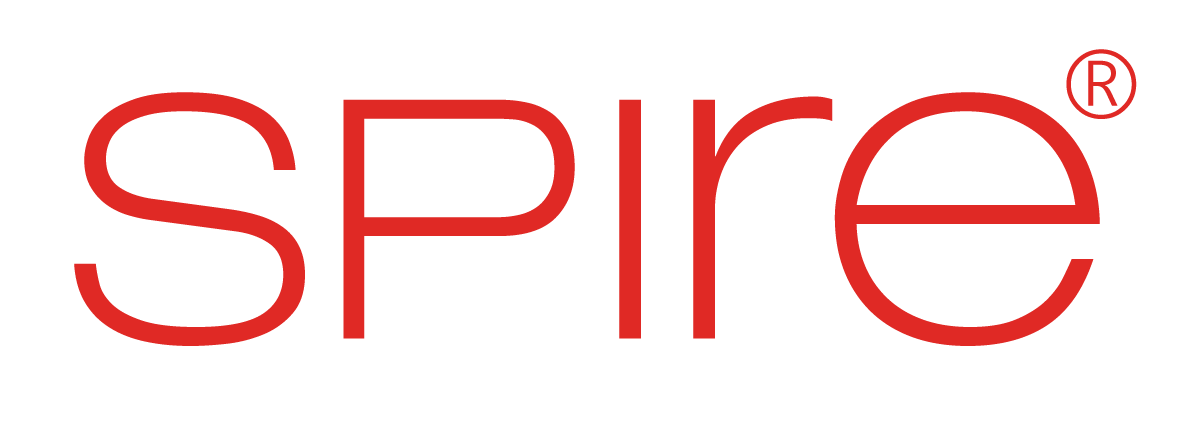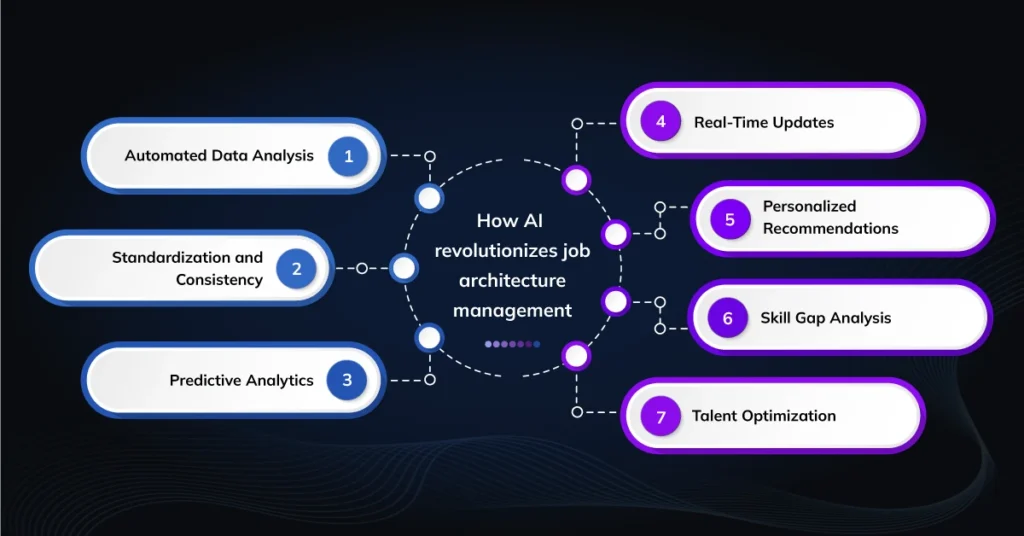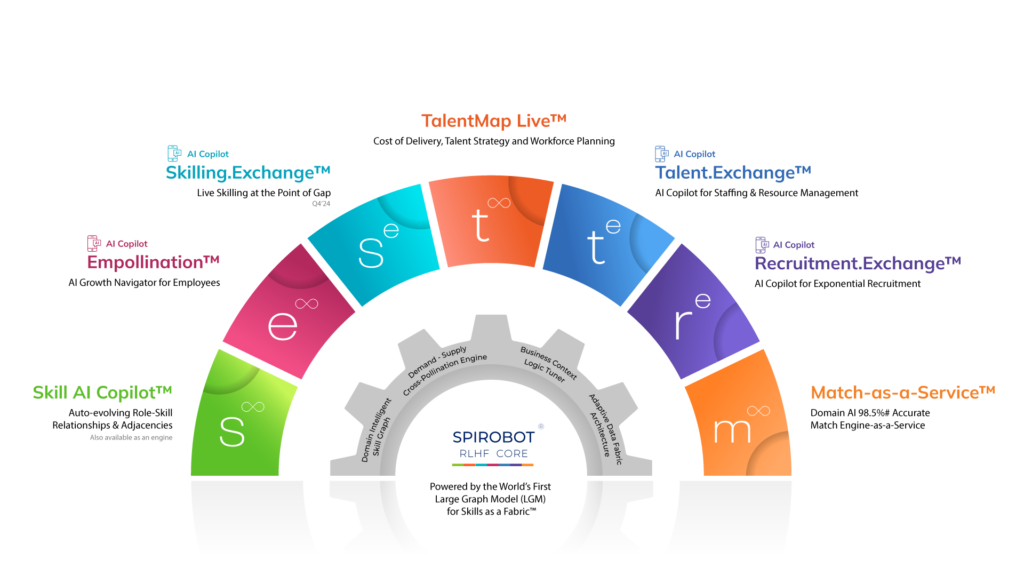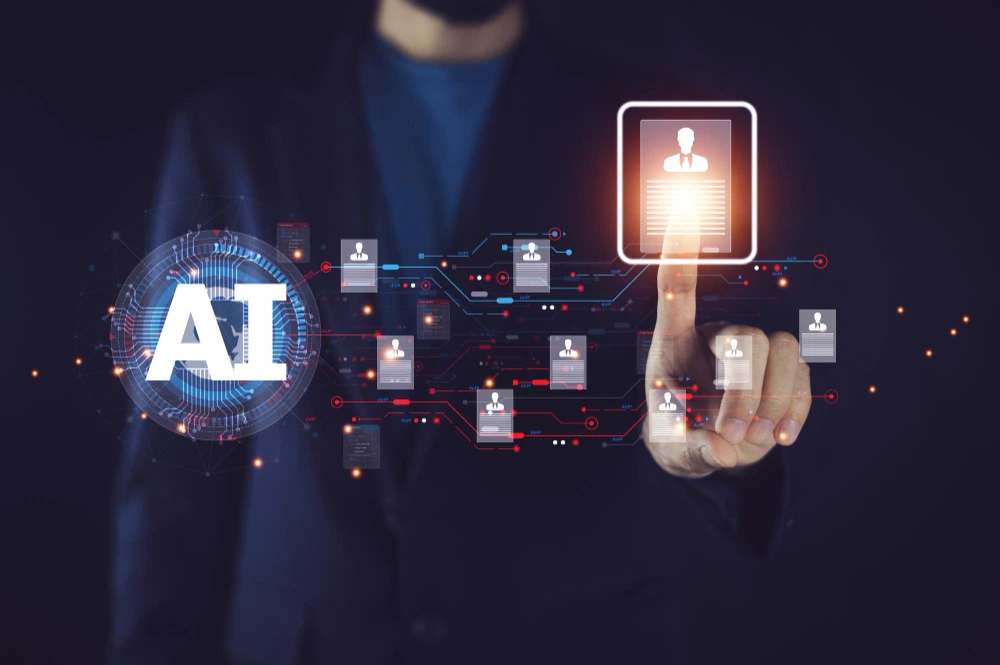The concept of job architecture forms the foundation of any successful organization. It defines the roles, responsibilities, and skills required to achieve specific business goals. A well-defined job architecture ensures clarity, efficiency, and alignment between employees and organizational objectives. However, maintaining a solid job architecture can be a complex challenge, especially in today’s dynamic business environment.
This blog post will explore organizations’ common challenges in managing their job architecture and how Artificial Intelligence (AI) can be harnessed to overcome these barriers and streamline the process.
What is Job Architecture?
Job architecture is a strategic framework that defines the roles, responsibilities, and skills required to achieve an organization’s goals. It provides a clear and consistent structure for managing the workforce, ensuring that employees are aligned with the organization’s strategic objectives and have the necessary skills to succeed.
Job architecture is a strategic framework that defines the roles, responsibilities, and skills required to achieve an organization’s goals.
A well-defined job architecture includes:
- Role Definitions: Clear and concise descriptions of each role within the organization, outlining the primary responsibilities, required skills, and reporting relationships.
- Skill Frameworks: A comprehensive inventory of the skills needed to perform various roles effectively, including technical skills, functional skills, and soft skills.
- Career Paths: Defined career progression pathways for employees, outlining potential growth opportunities and the skills required to advance within the organization.
- Competency Models: Standards of performance that define the knowledge, skills, and behaviors required for successful job performance.
The Importance of Job Architecture
A well-defined job architecture serves as the foundation for a successful organization. It provides a clear and consistent framework for managing roles, responsibilities, and skills, ensuring employees are aligned with the organization’s strategic objectives. A robust job architecture offers numerous benefits, including:
- Improved Talent Management: A clear understanding of roles and required skills enables organizations to recruit talent, develop effective performance management systems, and provide targeted learning and development opportunities.
- Enhanced Employee Engagement: When employees clearly understand their roles, responsibilities, and how they contribute to the organization’s success, they are more likely to feel engaged, motivated, and satisfied with their work.
- Streamlined Operations: A standardized job architecture promotes efficiency and consistency across the organization, leading to smoother workflows, reduced redundancy, and improved productivity.
- Strategic Workforce Planning: By identifying current and future skill needs, organizations can develop proactive workforce planning strategies to ensure they have the talent they need to achieve their goals.
- Fair Compensation: A well-defined job architecture helps establish fair and equitable compensation practices, ensuring that employees are rewarded appropriately for their contributions.
- Improved Organizational Agility: A flexible job architecture can help organizations adapt to changing business conditions and seize new opportunities. By defining roles and skills in a modular way, organizations can quickly reconfigure their workforce to meet evolving needs.
- Enhanced Decision Making: A clear job architecture provides a solid foundation for informed decision-making regarding talent acquisition, development, and deployment.
Significance of a Job Architecture
– Improved Talent Management
– Enhanced Employee Engagement
– Streamlined Operations
– Strategic Workforce Planning
– Fair Compensation
– Improved Organizational Agility
– Enhanced Decision Making
A robust job architecture is essential for organizations to thrive in today’s competitive business environment. A clear framework for managing roles, responsibilities, and skills enables organizations to optimize their workforce, improve efficiency, and achieve their strategic objectives.
Challenges in Maintaining Job Architecture
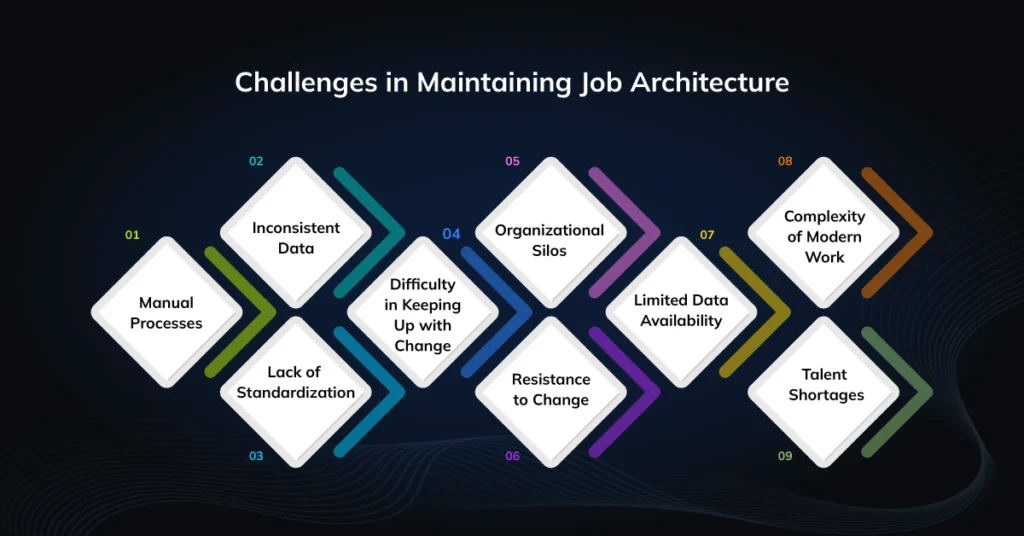
Maintaining a robust job architecture can be a complex and ongoing process, facing several significant challenges:
- Manual Processes: Traditional methods of managing job architecture often rely on manual data entry, analysis, and updates, which can be time-consuming, error-prone, and difficult to scale.
- Inconsistent Data: Job descriptions and skill requirements may vary across different departments or teams, leading to inconsistencies and making it difficult to compare roles or identify skill gaps.
- Lack of Standardization: The absence of standardized practices for defining roles and skills can result in confusion, ambiguity, and difficulties in comparing job roles and determining compensation.
- Difficulty in Keeping Up with Change: The business landscape constantly evolves, with new technologies, market trends, and organizational changes impacting job requirements. Updating a job architecture to reflect these changes can be time-consuming and challenging.
- Organizational Silos: In organizations with solid departmental silos, it can be challenging to achieve a unified and consistent job architecture across the entire organization.
- Resistance to Change: Introducing changes to the job architecture can be met with resistance from employees who may fear job insecurity or changes to their roles and responsibilities.
- Limited Data Availability: In some cases, organizations may not have access to the necessary data, such as performance data, skill assessments, or market information, to accurately define roles and skills.
- Complexity of Modern Work: The increasing complexity of modern work, including the rise of hybrid work arrangements, project-based work, and the gig economy, can make it challenging to define and manage traditional job roles.
- Talent Shortages: In tight labor markets, organizations may need help finding qualified candidates for specific roles, making maintaining a well-defined job architecture difficult.
Overcoming these challenges requires a strategic approach, including using advanced tools and technologies, effective communication, and a commitment to continuous improvement.
How Domain-Intelligent AI Can Revolutionize Job Architecture Management
Domain-Intelligent Artificial Intelligence (AI) offers a powerful solution to overcome the challenges associated with traditional job architecture management.
Here’s how Domain-Intelligent AI can revolutionize job architecture:
- Automated Data Analysis: Domain-Intelligent AI algorithms can analyze vast amounts of data from various sources, including job descriptions, performance reviews, employee surveys, and external market data. This automated analysis helps identify patterns, inconsistencies, and skill gaps within the job architecture.
- Standardization and Consistency: Domain-Intelligent AI can establish and enforce consistent practices for defining roles and skills, ensuring that job descriptions and skill requirements are clear, concise, and comparable.
- Predictive Analytics: Domain-Intelligent AI can leverage historical data to predict future skill needs based on industry trends, technological advancements, and organizational goals. This enables organizations to proactively update their job architecture and develop targeted training programs to bridge potential skill gaps.
- Real-Time Updates: AI-powered job architecture can be constantly updated in real-time as roles evolve and skill requirements change. This ensures that the organization’s talent management practices remain agile and responsive.
- Personalized Recommendations: Domain-Intelligent AI can provide hyper-personalized recommendations to employees based on their skills, interests, and career aspirations. This can help employees identify potential growth opportunities and develop their skills.
- Skill Gap Analysis: Domain-Intelligent AI can identify skill gaps within the organization and recommend targeted training and development programs to address these gaps.
- Talent Optimization: Domain-Intelligent AI can help organizations optimize their workforce by identifying underutilized skills, matching employees to the right roles, and improving succession planning.
The Benefits of AI-Powered Job Architecture Management
By leveraging Domain AI for job architecture management, organizations can achieve numerous significant benefits, including:
- Improved Efficiency: Domain-Intelligent AI automates time-consuming tasks like data analysis and reporting, freeing HR professionals to focus on strategic initiatives.
- Enhanced Decision Making: Domain-Intelligent AI-powered insights provide organizations with data-driven information to support informed talent acquisition, development, and deployment decisions.
- Increased Agility: Domain-Intelligent AI enables organizations to adapt their job architecture quickly and efficiently to changing business conditions, ensuring that the workforce remains aligned with strategic objectives.
- Enhanced Employee Engagement: Domain-Intelligent AI-powered job architecture can help create a more engaging and motivating work environment by providing employees with clear career paths, personalized development recommendations, and growth opportunities.
- Improved Talent Retention: Domain-Intelligent AI-powered job architecture can help organizations retain top talent and reduce turnover by investing in employee development and providing opportunities for growth.
- Reduced Costs: Domain-AI can help organizations reduce costs by optimizing the workforce, identifying skill gaps, and providing targeted training programs.
- Enhanced Organizational Performance: A well-defined and Domain AI-powered job architecture can improve organizational performance by ensuring that employees have the skills and knowledge they need to succeed.
- Improved Compliance: Domain-Intelligent AI can help organizations ensure compliance with relevant employment laws and regulations by providing accurate and up-to-date information on role requirements and compensation.
- Enhanced Innovation: A flexible and adaptable job architecture can foster a culture of innovation by encouraging employees to experiment with new ideas and take on new challenges.
- Improved Customer Experience: A well-defined job architecture can help organizations deliver exceptional customer experiences by ensuring employees have the skills and knowledge needed to meet customer needs.
By embracing AI-powered job architecture, organizations can unlock many benefits that improve efficiency, effectiveness, and overall success.
Spire.AI: Building a Solid Job Architecture with Domain-Intelligent AI at the Core
Building and maintaining a solid job architecture is critical for success in today’s dynamic business landscape. However, traditional methods can be cumbersome and inefficient. This is where Spire.AI offers a comprehensive suite of AI-powered solutions specifically designed to revolutionize how organizations manage their job architecture.
Here’s how Spire.AI empowers organizations to build a solid and future-proof job architecture with AI:
- Auto-Evolving Role-Skill Framework: Spire.AI’s core offering tackles the challenge of outdated and static skill matrices. Its groundbreaking solution leverages a domain-intelligent Large Graph Model (LGM) to identify skill combinations and skill requirements for every role automatically. This framework evolves continuously, adapting to industry trends, technological advancements, and organizational changes. Imagine a job architecture that learns and grows alongside your business, ensuring constant alignment with your strategic goals.
- Domain-Intelligent AI-Powered Data Analysis: Spire.AI goes beyond traditional data collection, utilizing Domain AI to analyze vast amounts of information from diverse sources. This includes job descriptions, employee profiles, performance reviews, industry benchmarks, and internal learning content. By leveraging Domain-Intelligent AI, Spire.AI can identify hidden patterns, inconsistencies, and skill gaps within the job architecture. This deep analysis provides invaluable insights and eliminates the need for time-consuming manual data analysis, freeing HR professionals to focus on strategic initiatives.
- Standardized and Transparent Skill Definitions: Inconsistencies in skill definitions can lead to clarity and interpretation within the organization. Spire.AI addresses this challenge by providing a standardized skills framework with clear and consistent definitions. This ensures everyone is on the same page, fostering greater clarity and transparency throughout the entire job architecture.
- Automated Skill Profiling: Traditional methods of employee skill mapping are often manual and time-consuming. Spire.AI utilizes Domain-Intelligent AI to automate this process, generating accurate and comprehensive skill profiles for a significant portion of the workforce based on minimal input, such as job titles. This saves time and resources and provides a data-driven foundation for talent development and deployment.
- Skill Gap Analysis: Spire.AI leverages Domain-Intelligent AI and LGM to analyze historical data and industry trends, pinpointing potential skill gaps before they become challenging. With this foresight, organizations can proactively update their job architecture and implement targeted training programs to bridge the gaps, ensuring a future-ready workforce.
- Real-Time Updates: The business landscape is constantly evolving, and so should your job architecture. Spire.AI’s AI-powered solution continually updates in real time as roles evolve and new skills become necessary. This ensures your job architecture remains agile and reflects your organization’s ever-changing needs.
Beyond Efficiency: The Human Impact of AI-Powered Job Architecture
While efficiency is a key benefit of Spire.AI’s solutions, the impact goes beyond streamlining processes. By empowering organizations to build a robust and future-proof job architecture, Spire.AI fosters a positive impact on employees and the overall work environment:
- Empowering Employees: AI-powered skill profiles and personalized career path recommendations from Spire.AI provide employees with a clear understanding of their strengths, weaknesses, and development opportunities. This empowers them to take ownership of their careers and pursue organizational growth.
- Enhanced Employee Engagement: Employees who feel their skills are valued and have clear pathways for advancement are more likely to be engaged and motivated. Spire.AI contributes to a more engaged workforce by fostering a culture of continuous learning and development.
- Improved Talent Mobility: A well-defined job architecture makes it easier for employees to identify organizational opportunities that align with their skills and aspirations. Spire.AI’s Talent Marketplace further facilitates internal mobility by enabling skills-based matching for job openings, providing employees with opportunities for growth and career progression within the company.
By leveraging Spire.AI’s AI-powered solutions, organizations can overcome the limitations of traditional job architecture management and build a future-proof system that fosters efficiency, agility, and a thriving workforce.
Final Thoughts
In today’s rapidly evolving business landscape, a well-defined and adaptable job architecture is essential for organizations to succeed. Traditional methods of managing job architecture are often time-consuming and error-prone and struggle to keep pace with the changing needs of the modern workplace.
Domain-Intelligent Artificial Intelligence (AI) offers a powerful solution to these challenges. Domain-Intelligent AI can revolutionize how organizations manage their job architecture by automating data analysis, standardizing processes, and providing predictive insights.
Spire.AI is a leading provider of AI-powered talent management solutions to help organizations build and maintain a robust job architecture. Spire.AI’s Auto-Evolving Role-Skill Framework, combined with its other AI-powered features, empowers organizations to:
- Automate: Streamline manual processes and reduce the time and effort required to manage job architecture.
- Standardize: Ensure consistency and clarity in role definitions and skill requirements.
- Personalize: Provide employees with personalized career path recommendations and development opportunities.
- Optimize: Enhance talent management processes and improve overall organizational performance.
By leveraging AI-powered solutions like Spire.AI, organizations can build a more efficient, effective, and agile job architecture that supports their strategic goals and fosters a thriving workforce.
